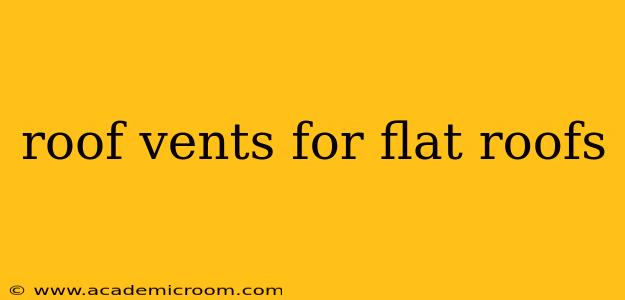Flat roofs, while aesthetically pleasing and often cost-effective, present unique challenges when it comes to ventilation. Proper ventilation is crucial for preventing moisture buildup, extending the lifespan of your roof, and maintaining a comfortable indoor environment. This guide explores the various types of roof vents for flat roofs, their applications, and factors to consider when choosing the right system for your needs.
What are the different types of roof vents for flat roofs?
Several types of vents effectively address ventilation needs on flat roofs. These include:
-
Low-Profile Vents: These are designed to sit flush or nearly flush with the roof surface, minimizing their visual impact. They often feature a low profile design to maintain the aesthetics of the flat roof.
-
Curb-Mounted Vents: These vents are installed on top of a raised curb, creating a small, elevated structure on the roof. This curb provides a better air intake and exhaust.
-
Solar-Powered Vents: Utilizing solar energy, these vents automatically open and close based on temperature and humidity levels, optimizing ventilation and energy efficiency. This eliminates the need for electric power.
-
Exhaust Fans: For situations requiring higher ventilation rates, exhaust fans can be incorporated into the flat roof system to actively remove stale air and moisture. These often require electrical connections.
What are the benefits of using roof vents on flat roofs?
Proper ventilation offers numerous advantages, directly impacting the longevity and functionality of your building. Key benefits include:
-
Preventing Moisture Buildup: Moisture is a significant enemy of flat roofs. Vents help remove trapped moisture, preventing mold, mildew, and structural damage.
-
Extending Roof Lifespan: By reducing moisture damage, roof vents significantly extend the lifespan of your roofing materials, saving you money on costly repairs and replacements.
-
Improving Indoor Air Quality: Adequate ventilation helps regulate indoor temperature and humidity levels, contributing to a healthier and more comfortable living or working environment.
-
Preventing Overheating: In hot climates, roof vents can help reduce heat buildup under the roof, lowering energy costs associated with cooling.
-
Reducing Condensation: Condensation on the underside of the roof can lead to problems. Good ventilation helps to reduce this.
How do I choose the right roof vent for my flat roof?
Selecting the appropriate roof vent requires careful consideration of several factors:
-
Roof Size and Design: The size of your roof and its overall design will dictate the number and type of vents needed for effective ventilation. A larger roof will require a more robust ventilation system.
-
Climate: Climatic conditions play a crucial role. In humid climates, more powerful ventilation is usually necessary to prevent moisture buildup.
-
Building Code Requirements: Always check local building codes and regulations to ensure your chosen vents comply with all applicable standards. This could impact the type and placement of vents.
-
Budget: Vents vary in price, from low-cost basic models to more sophisticated, energy-efficient options. Consider your budget constraints and prioritize features that address your specific needs.
What are the common problems with flat roof ventilation?
Inadequate ventilation can lead to several serious problems:
-
Roof Leaks: Trapped moisture can weaken roofing materials, leading to leaks and water damage.
-
Mold and Mildew Growth: Excessive humidity provides the ideal breeding ground for mold and mildew, posing health risks and causing damage to the building structure.
-
Structural Damage: Moisture damage can weaken supporting structures, compromising the overall integrity of the building.
-
Premature Roof Failure: Poor ventilation significantly reduces the lifespan of your roof, resulting in premature failure and costly replacements.
How much does it cost to install roof vents on a flat roof?
The cost of installing roof vents on a flat roof varies greatly depending on several factors, including:
- The size of the roof.
- The type of vents chosen.
- The complexity of the installation.
- Labor costs in your area.
It's recommended to obtain quotes from multiple reputable roofing contractors to determine the accurate cost for your specific project.
How often should I inspect my flat roof vents?
Regular inspections of your flat roof vents are crucial for maintaining optimal performance and preventing potential problems. Aim for at least annual inspections, paying close attention to:
-
Proper Functioning: Ensure that vents are opening and closing correctly (if applicable).
-
Signs of Damage: Check for cracks, leaks, or other signs of wear and tear.
-
Clogging: Debris can accumulate, blocking airflow. Clean vents regularly to maintain efficiency.
By understanding the various types of vents and their functions, and by diligently maintaining your ventilation system, you can significantly extend the life of your flat roof and ensure a healthy, comfortable indoor environment. Remember to always consult with a qualified roofing professional for advice tailored to your specific situation.
